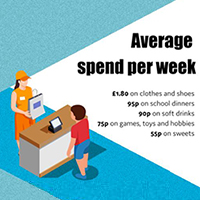Top tips for teaching your kids to save money

 Saving money isn’t always easy, no matter what age you are, and establishing an awareness for money at an early age can certainly go a long way toward building healthy spending habits for later in life.
Saving money isn’t always easy, no matter what age you are, and establishing an awareness for money at an early age can certainly go a long way toward building healthy spending habits for later in life.
That’s why it’s important for parents and guardians to teach little ones about saving money. Whether it’s learning to count or counting the pounds for a new toy, you can pass on your wisdom to help set them up for a bright financial future.
According to the Office of National Statistics (ONS), the average weekly spend for seven year-olds is £7.40. By age 15, that figure more than doubles to £25 a week, so there’s no question children know how to spend money – whether it’s theirs or ours!
However, more than 15% of parents say they don’t feel confident teaching their kids about money. Introducing your child to money doesn’t need to be taxing. The experts at Sainsbury’s Bank have put together their Guide to Teaching Kids to Save with some fun and simple ways to teach kids of all ages financial responsibility.
1. Managing money
The first thing to consider is teaching your child how to manage money.
With younger children under seven years of age, handling money may be a bit daunting. One way to get them used to money management is to give them the correct change to pay for something, like bus fare. Let them count the money out and pay for themselves to help boost their confidence.
You could also think about giving older children aged between seven and 11 years old a small allowance. Be sure to talk about the value of items and explain what they can afford with their allowance, for example two bags of sweets or one magazine.
2. Sensible shopping
Another thing to consider when teaching your child to save money is sensible shopping habits.
Younger children might enjoy playing shop with toy items and money, and you can join in to help them develop their counting skills and learn about the value of different coins.
You might not always agree with you child’s spending choices, but allowing your teen to make some financial mistakes gives them a chance to learn. If they make an unnecessary purchase or spend too much on an item, be open to talking about poor spending choices without telling them off.
3. Delayed gratification
Rather than allowing children to spend their money all at once, introduce the idea of delaying gratification.
One way to do this is to set chores or tasks for your child to earn part of their allowance at a time. This will help them understand the importance of working for money and waiting to spend it.
4. Saving
 With these foundations in place, your child is in a good position to start learning about saving money.
With these foundations in place, your child is in a good position to start learning about saving money.
A piggy bank is a fun way to introduce children under the age of seven the idea of saving money. Have them put aside some money from gifts or tooth fairy visits and then count it together.
Between the ages of seven and 11, you could help your child set some short savings goals. Start with an upcoming holiday or event and work out how much they need to save to reach their goal.
Finally, you can teach older children about banking by taking them with you to set up a savings account and showing them statements or banking apps. This is a great way to get them used to some different banking terms as you show them how to manage their money by themselves.
Author:



